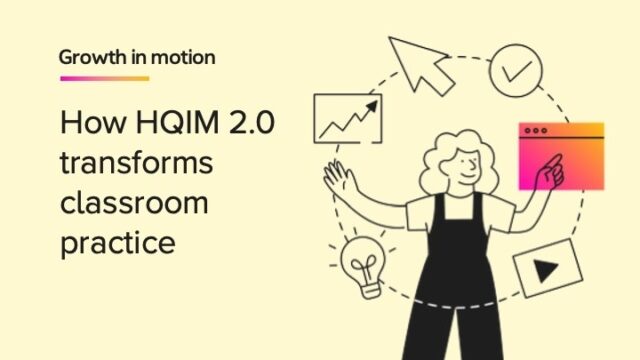
I’ve had a lot of experience working with students and education professionals as a former READ 180 teacher, a national board-certified teacher, and an HMH Services consultant. Extensive learning about student-centered coaching by Diane Sweeney, an educational consultant, helped me identify instructional coaching to develop teacher leaders.
We institute a student-centered approach to coaching and incorporate a specific coaching protocol. Student-centered coaching keeps student work at the center of each coaching session. When partnering with a school or district, the coaching cycle typically includes meeting with each teacher once a month over the course of the school year. Each month, we start by looking at last month’s goals to see how students have progressed.
Ongoing communication with a school-based coach or administrator can further strengthen the coaching that we as consultants provide. A student-centered coaching model increases student achievement—coaches explain or model components of the rotational model for READ 180, analyze data and formulate student-centered goals for future instruction with the classroom teacher, and empower school coaches to successfully sustain the coaching cycle. We strive to build a greater understanding of the wide array of resources available to the teacher to meet their students’ individual needs.
Examples of how to develop a student-centered approach to coaching
Differentiated instruction
When we partnered with a Florida school district, one of the teachers I worked with said all of her students using System 44, a program that has since been integrated into Read 180, moved to the U.S. from other nations, primarily Haiti, Guatemala, and Cuba. None of these students knew how to speak English. At the start of the school year, we quickly realized that the System 44 student workbook, beginning at Module 1, was too advanced for her students. We knew her students needed more foundational work with phonics.
During our coaching sessions, I showed the teacher the Resources for Differentiated Instruction (RDI) lessons, along with other Student Achievement Manager (SAM) resources, and I explained how phonics lessons can be targeted in her small-group instruction. The shift to more differentiated instruction led to a successful year for the teacher and her students.
Modeling
An example of modeling during the coaching partnership occurred when I was working with a READ 180 elementary teacher. During other coaching sessions, we looked at independent reading data. We wanted to see students develop skills to succeed at reading on grade level as measured by quizzes. Therefore, I suggested the use of eReads, which are texts that relate directly to what a student is working on in the READ 180 software, to provide additional background knowledge and boost their vocabulary.
I modeled how to access eReads during small-group instruction and how to utilize eReads to challenge the students as readers. This approach enabled students to read informational texts above their reading level and successfully pass their independent reading quizzes! The teacher told me that this coaching process was essential to helping her develop as a READ 180 teacher. It let her further cater to students’ needs in her small-group lessons.
Tracking students’ progress
During a subsequent coaching session, we reviewed the teacher’s classroom software data and noticed that students didn’t have very many READ 180 segments completed. We knew they could improve but we needed a way to track student progress, and I suggested using an incentive chart to do just that! The teacher said her students loved putting stickers on the chart after completing each segment and competing to see who earned the most. This method proved effective, and the students seemed to enjoy participating.

Establishing specific goals
Evaluating data and generating student-centered goals is another powerful process in coaching. Using these two approaches while partnering with an on-site school-based literacy coach proved to be successful. This process worked because we followed a highly effective coaching cycle:
- Set goals.
- Teach the necessary strategies needed to reach those goals.
- Observe classes and review relevant data.
- Give teachers the time to reflect on what worked.
In the first step—setting a goal—we worked to understand the district’s objectives for the programs and then worked to revise those goals, explain why we made changes, and discuss ways we could work together to achieve those goals.
Our next step was to have the educators move forward with actually teaching those lessons while putting into practice the skills we taught them. A blueprint helped us maintain a checklist of our goals, what we had learned so far, and what we hoped to achieve.
Next, we evaluated data to determine whether we had achieved those goals. For instance, if a teacher initially had trouble with the timing of rotations, I would watch the class and make suggestions for improvement based on data. Finally, the teachers would reflect on whether they felt they had achieved their goals. I started every session by reviewing the goals and discussing why they had been achieved—or why they hadn’t.
Using these approaches to student-centered coaching, we provide the support needed to help teachers become more effective instructors and truly make a difference in students’ lives.
The views expressed in this article are those of the author and do not necessarily represent those of HMH.
***
Learn more about how our approach to instructional coaching can support teachers in meeting their professional goals with HMH Coachly.
This blog, originally published in 2018, has been updated for 2025.
Download Building Your School Culture: An Administrator’s Guide today.














